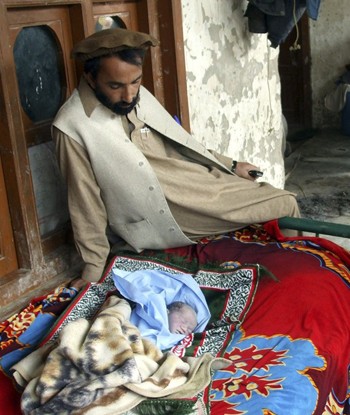By Dave Lindorff
When I was a 17-year-old kid in my senior year of high school, I didnt think much about Vietnam. It was 1967, the war was raging, but I didnt personally know anyone who was over there, Tet hadnt happened yet. If anything, the excitement of jungle warfare attracted my interest more than anything (I had a .22 cal rifle, and liked to go off in the woods and shoot at things, often, Ill admit, imagining it was an armed enemy.)

A villager looks at an infant boy who died after a military raid in a village in Gurbuz district of Khost province April 9, 2009. (Photo: Reuters)
Photo Gallery of US victims in Afghanistan
The Afghan Victim Memorial Project by Prof. Marc
But then I had to do a major project in my humanities program and I chose the Vietnam War. As I started researching this paper, which was supposed to be a multi-media presentation, I ran across a series of photos of civilian victims of American napalm bombing. These victims, often, were women and childreneven babies.
The project opened my eyes to something that had never occurred to me: my countrys army was killing civilians. And it wasnt just killing them. It was killing them, and maiming them, in ways that were almost unimaginable in their horror: napalm, phosphorus, anti-personnel bombs that threw out spinning flechettes that ripped through the flesh like tiny buzz saws. I learned that scientists like what I at the time wanted to become were actually working on projects to make these weapons even more lethal, for example trying to make napalm more sticky so it would burn longer on exposed flesh.
By the time I had finished my project, I had actively joined the anti-war movement, and later that year, when I turned 18 and had to register for the draft, I made the decision that no way was I going to allow myself to participate in that war.
A key reason myand millions of other Americans--eyes were opened to what the US was up to in Indochina was that the media at that time, at least by 1967, had begun to show Americans the reality of that war. I didnt have to look too hard to find the photos of napalm victims, or to read about the true nature of the weapons that our forces were using.
Today, while the internet makes it possible to find similar information about the conflicts in the world in which the US is participating, either as primary combatant or as the chief provider of arms, as in Gaza, one actually has to make a concerted effort to look for them. The corporate media which provide the information that most Americans simply receive passively on the evening news or at breakfast over coffee carefully avoid showing us most of the graphic horror inflicted by our military machine.
We may read the cold fact that the US military, after initial denials, admits that its forces killed not four enemy combatants in an assault on a house in Afghanistan, but rather five civiliansincluding a man, a female teacher, a 10-year-old girl, a 15-year-old boy and a tiny baby. But we dont see pictures of their shattered bodies, no doubt shredded by the high-powered automatic rifles typically used by American forces.
We may read about wedding parties that are bombed by American forcessomething that has happened with some frequency in both Iraq and Afghanistan-- where the death toll is tallied in dozens, but we are, as a rule, not provided with photos that would likely show bodies torn apart by anti-personnel bombsa favored weapon for such attacks on groups of supposed enemy fighters. (A giveaway that such weapons are being used is a typically high death count with only a few wounded.)
Obviously one reason for this is that the US military no longer gives US journalists, including photo journalists, free reign on the battlefield. Those who travel with troops are under the control of those troops and generally aren't allowed to photograph the scenes of devastation, and sites of such mishaps are generally ruled off limits until the evidence has been cleared away.
But another reason is that the media themselves sanitize their pages and their broadcasts. It isnt just American dead that we dont get to see. Its the civilian deadat least if our guys do it. We are not spared gruesome images following attacks on civilians by Iraqi insurgent groups, or by Taliban forces in Afghanistan. But we dont get the same kind of photos when its our forces doing the slaughtering. Because often the photos and video images do existtaken by foreign reporters who take the risk of going where the US military doesnt want them.
No wonder that even today, most Americans oppose the wars in Iraq and Afghanistan not because of sympathy with the long-suffering peoples of those two lands, but because of the hardships faced by our own forces, and the financial cost of the two wars.
For some real information on the horror that is being perpetrated on one of the poorest countries in the world by the greatest military power the world has ever known, check out the excellent work by Professor Marc Herold at the University of New Hampshire (http://cursor.org/ and http://www.rawa.org/).
Dave Lindorff is a Philadelphia-based journalist and columnist. His latest book is The Case for Impeachment (St. Martins Press, 2006 and now available in paperback). He can be reached at dlindorff@mindspring.com



